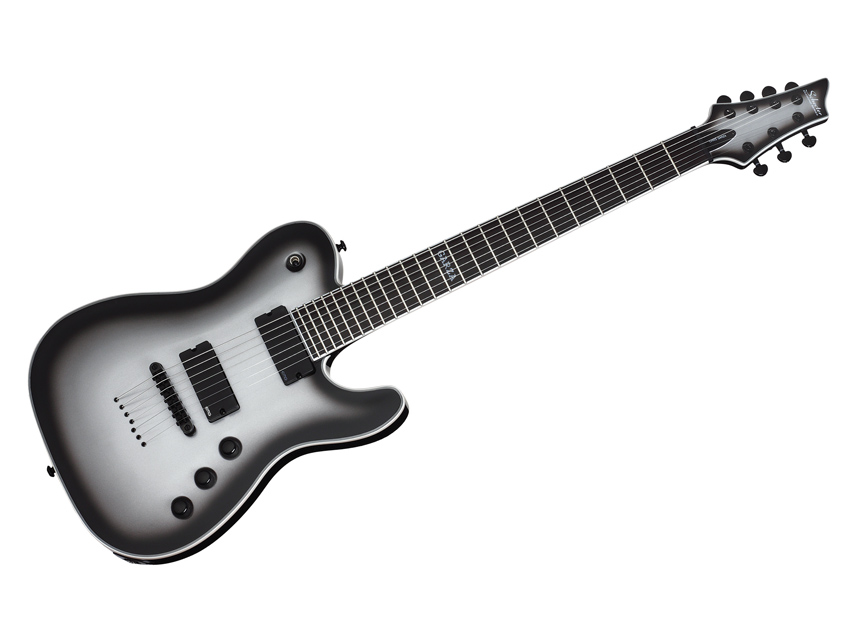MusicRadar Verdict
Awesome modern twist on classic stylings: overcome your preconceptions and check out the range of this grown-up seven-string.
Pros
- +
Serious class and subtlety for a seven-string...
Cons
- -
...but can it overcome metalhead stereotyping?
MusicRadar's got your back
Chris Garza is the guitarist for Californian deathcore champs Suicide Silence, which means his day job requires dropping his low B string to A, gunning a Mesa/Boogie Dual Rectifier and throttling out a cornucopia of brutal riffs.
It's a tough shift, which could explain why his signature seven-string is so physically imposing. It's as though Leo Fender's comic book nemesis fed the classic Telecaster body shape steroids until it was packing enough muscle to house two active EMG pickups and military grade hardware like its TonePros bridge.
"The set neck, fat frets, big body and Ultra Access neck heel offer supernatural sustain and unfettered access for soloing, but there's plenty of sonic range too."
Aside from this hulking slab of mahogany's weight, the first thing that strikes you is that the contemporary silverburst finish, multi-ply binding and ebony fretboard give the Garza a touch of class. This debonair aesthetic is sure to have crossover appeal for those alienated by overtly metal guitars, and it's great to see such a modern twist on a classic shape.
Schecter and Garza deserve a lot of credit for the finesse and restraint in the design. Given that Garza's an out-and-out metal kid, it's ironic that his signature guitar may help draw those without a taste for the heavy stuff towards seven-strings.
Sure, the metalheads will blow their cash after playing it, since the set neck, fat frets, big body and Ultra Access neck heel offer supernatural sustain and unfettered access for soloing, but there's plenty of sonic range too.
Sounds
The pickup combination offers a seven-string version of a classic pairing we've seen work well in so many six-strings, with an EMG 81-7 in the bridge and EMG 60-7 in the neck. Both are high-output, but the EMG 81-7 is that bit hotter, packing the nuclear tones required for low-end rock/metal riffs, solos and harmonic squeals.
The EMG 60-7 is striking as a more subtle rhythm pickup, and positively glassy when playing clean tones. There's nothing in the rulebook that stops jazz guitarists from rolling back the treble and throwing complex chord patterns or tapped melodies onto the Garza's fretboard.
Futurists, the heavy metal 2.0 generation, djent bands, frontiersmen of prog: the Garza is for you. If you're seeking a grown-ups' seven-string, you'll love this.
Of course, the Garza is like any other seven-string, eliciting that same Pavlovian Korn riff response from anyone from a six-string background. It's the fretboard geography, that extra string, that forces your hand.
But relax and give it 10 minutes until the brain stem can process something more complicated and you'll recover.
New riff possibilities will soon reveal themselves and, when they do, you'll realise that the Garza is not only one of the most versatile seven-strings on the market, but one that will encourage you to experiment with - and find new facets to - your playing.
Jonathan Horsley has been writing about guitars and guitar culture since 2005, playing them since 1990, and regularly contributes to MusicRadar, Total Guitar and Guitar World. He uses Jazz III nylon picks, 10s during the week, 9s at the weekend, and shamefully still struggles with rhythm figure one of Van Halen’s Panama.
“We were arguing a lot and we were miserable”: How Green Day exceeded expectations with their most ambitious song
"There’s plenty for us guitarists to learn – and ‘less is more’ is the overriding lesson": how to play like George Harrison on The Beatles' Abbey Road
“They didn’t like Prince’s bikini underwear”: Prince’s support sets for the The Rolling Stones in 1981 are remembered as disastrous, but guitarist Dez Dickerson says that the the crowd reaction wasn’t as bad as people think











